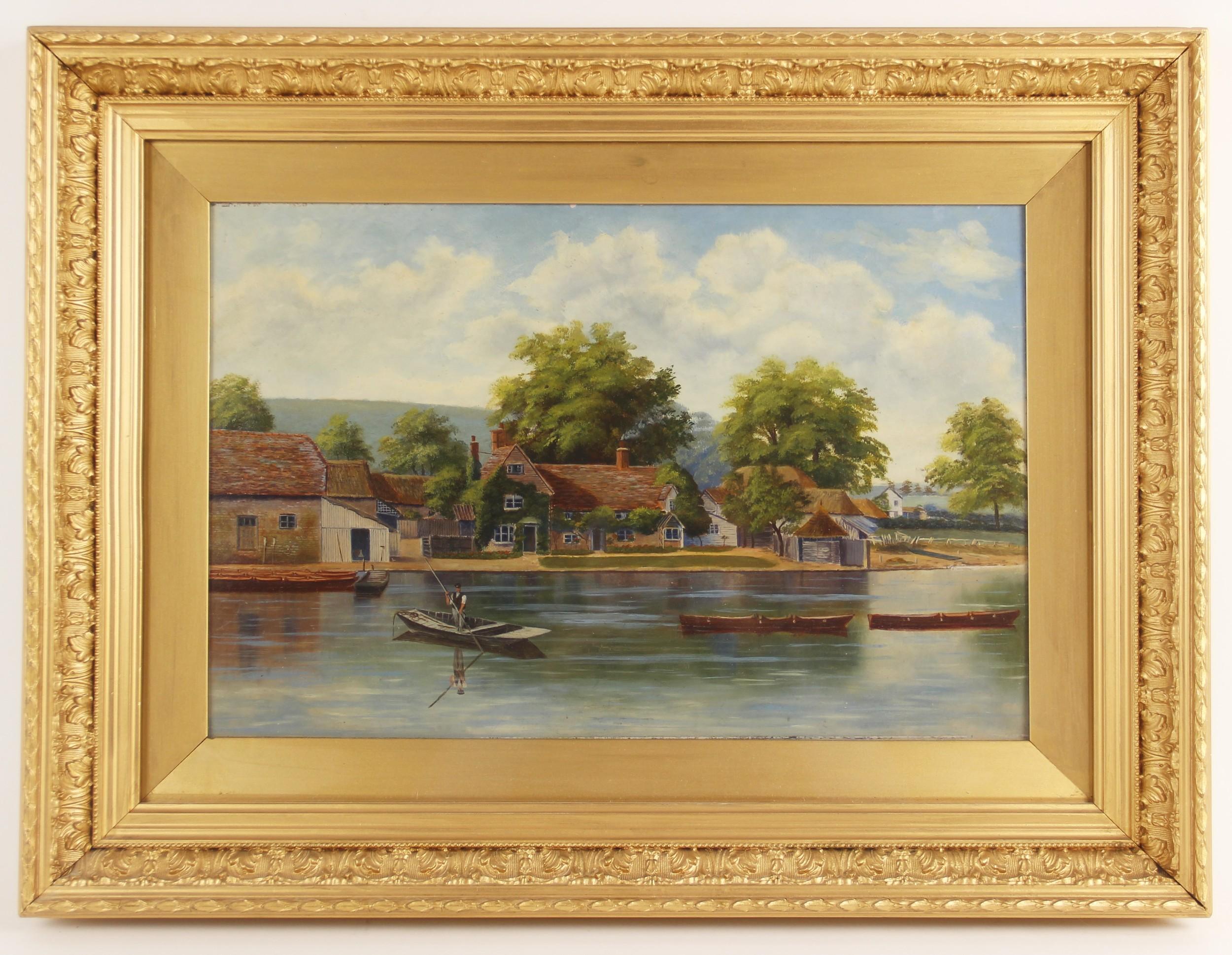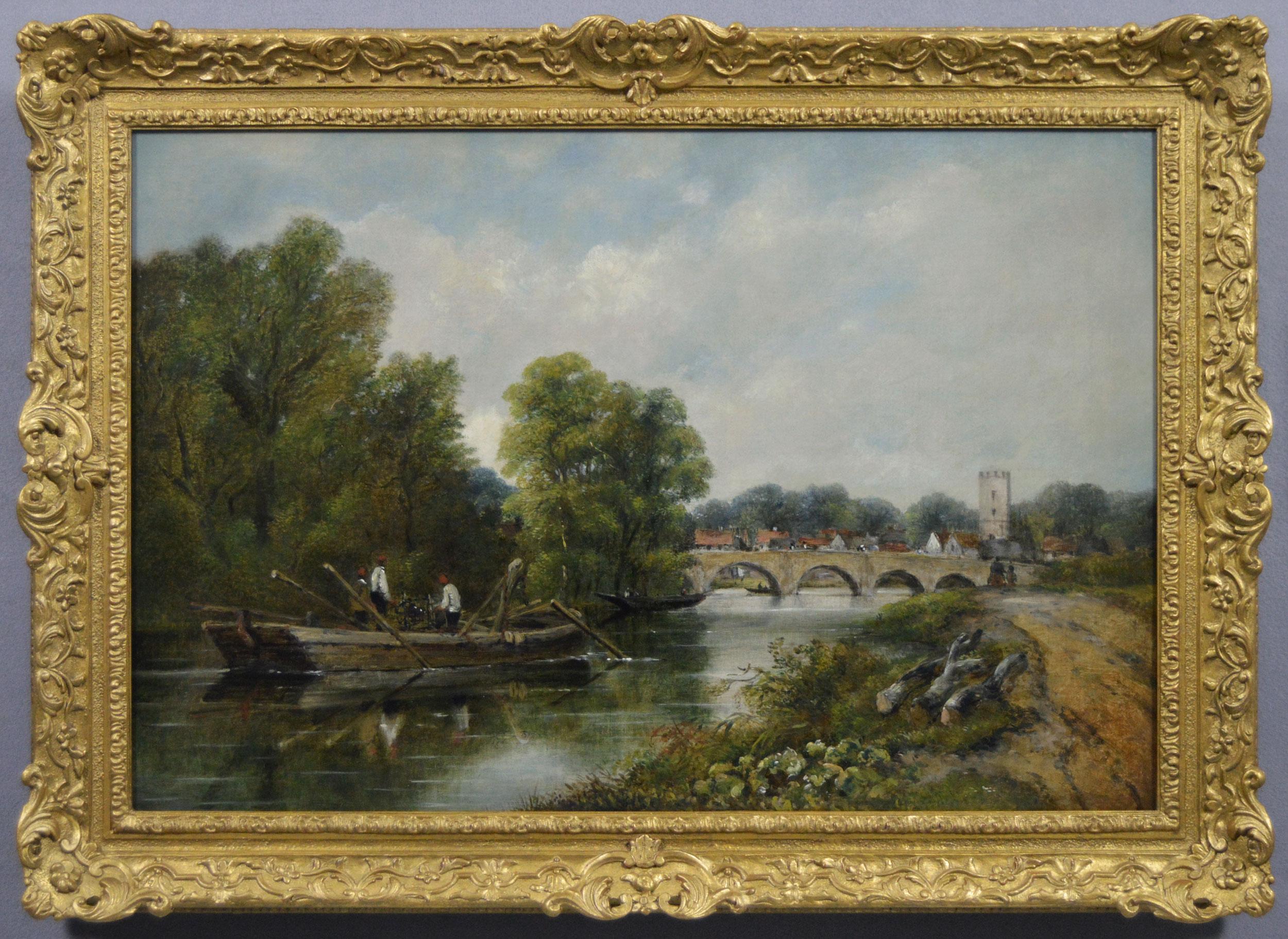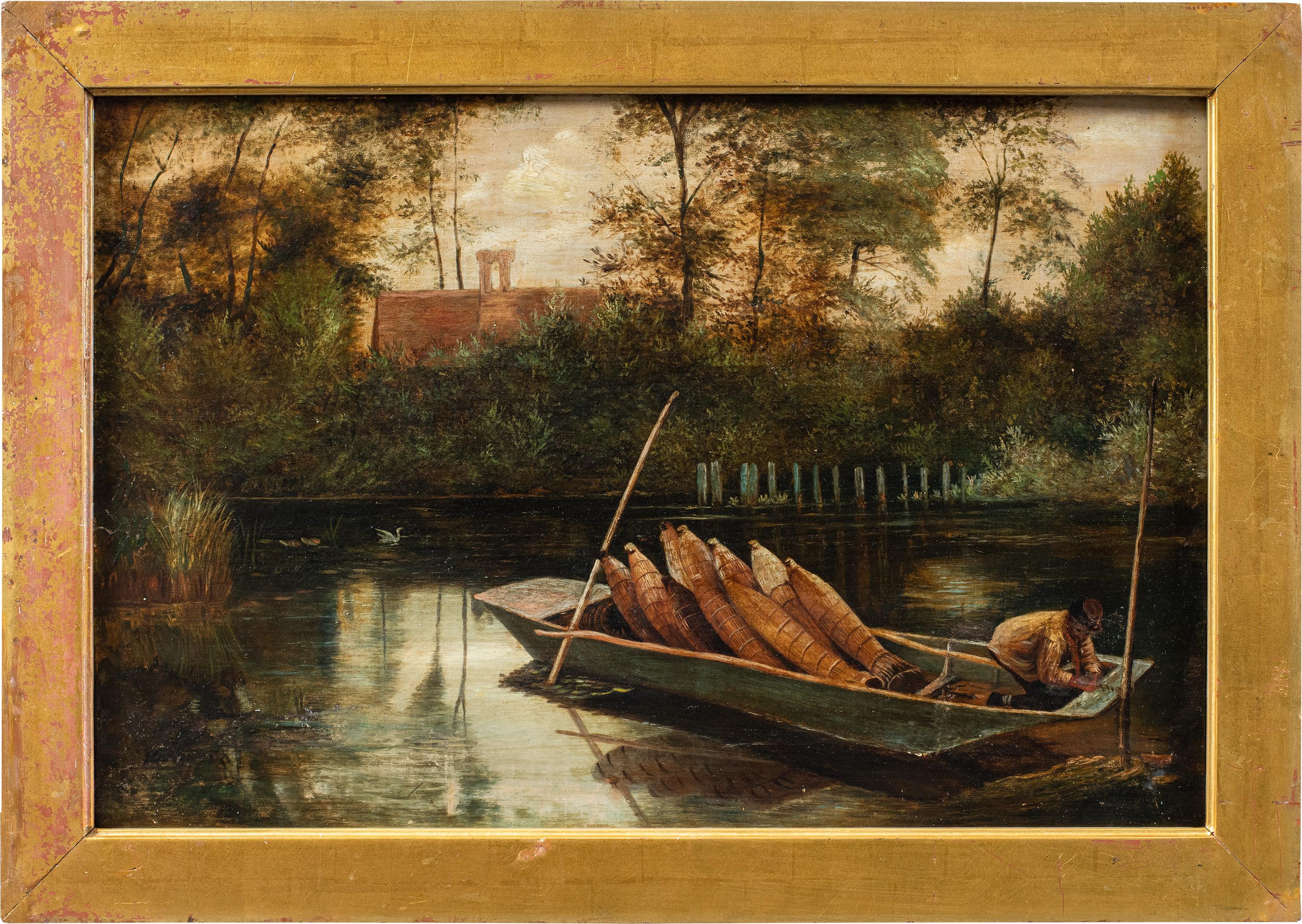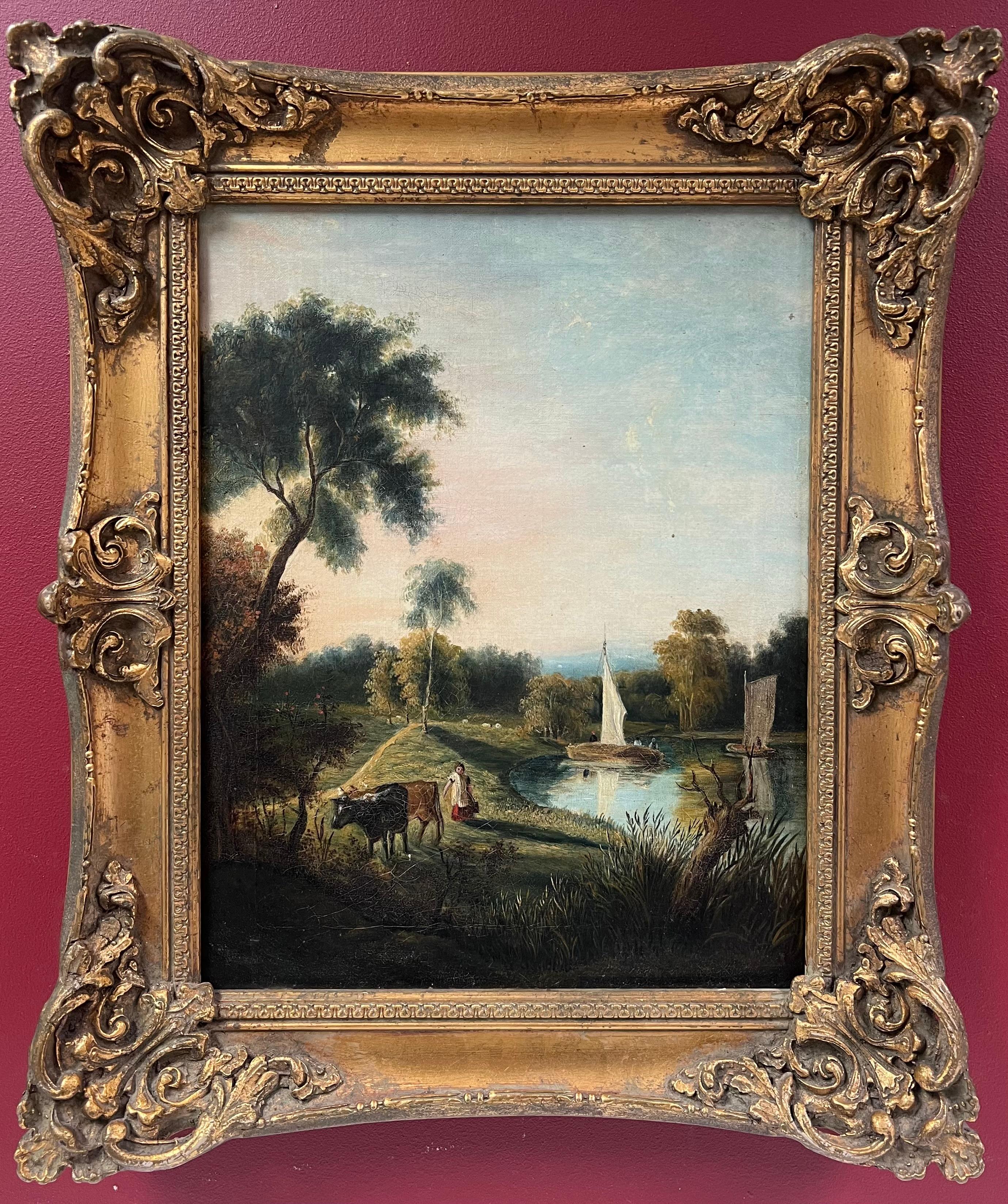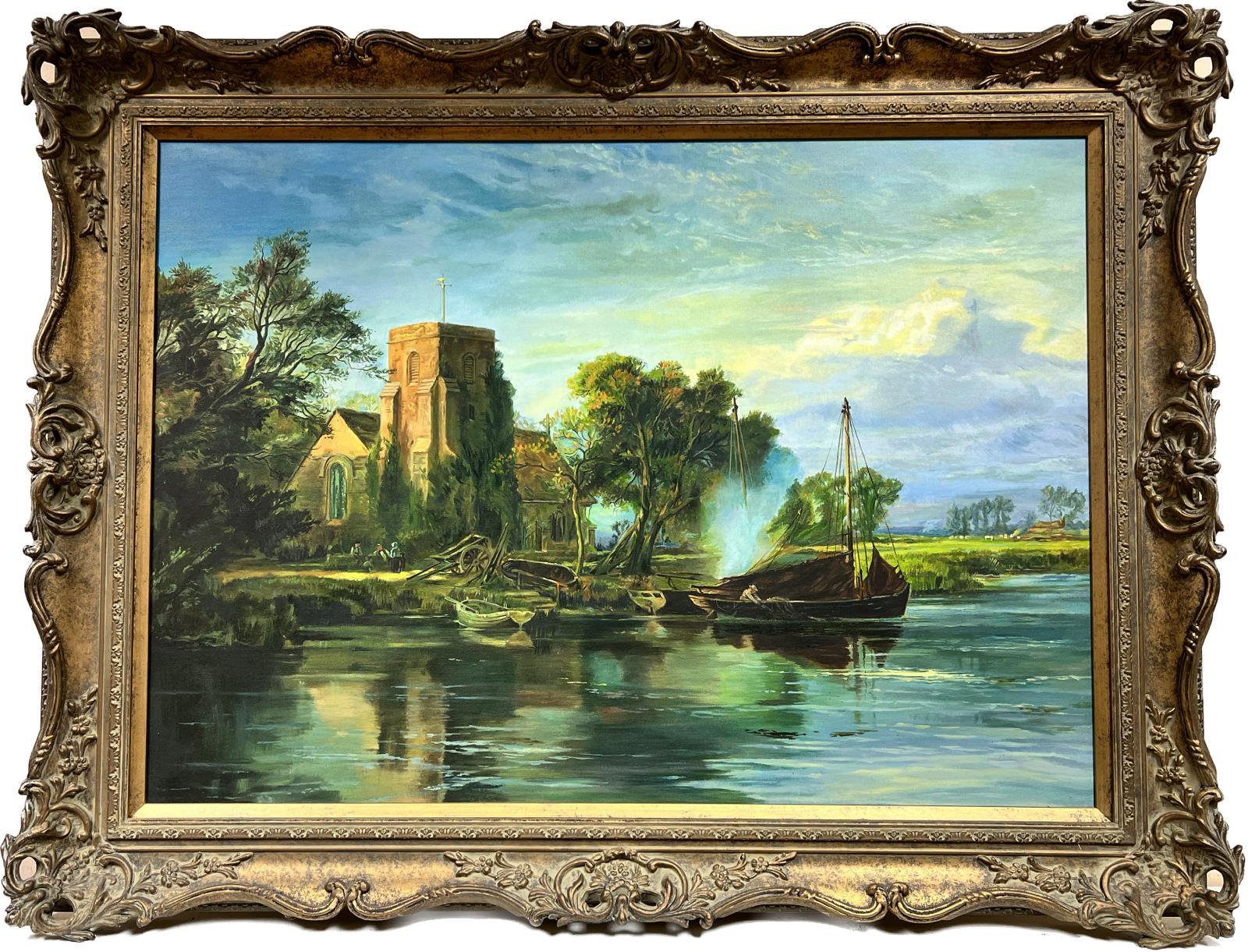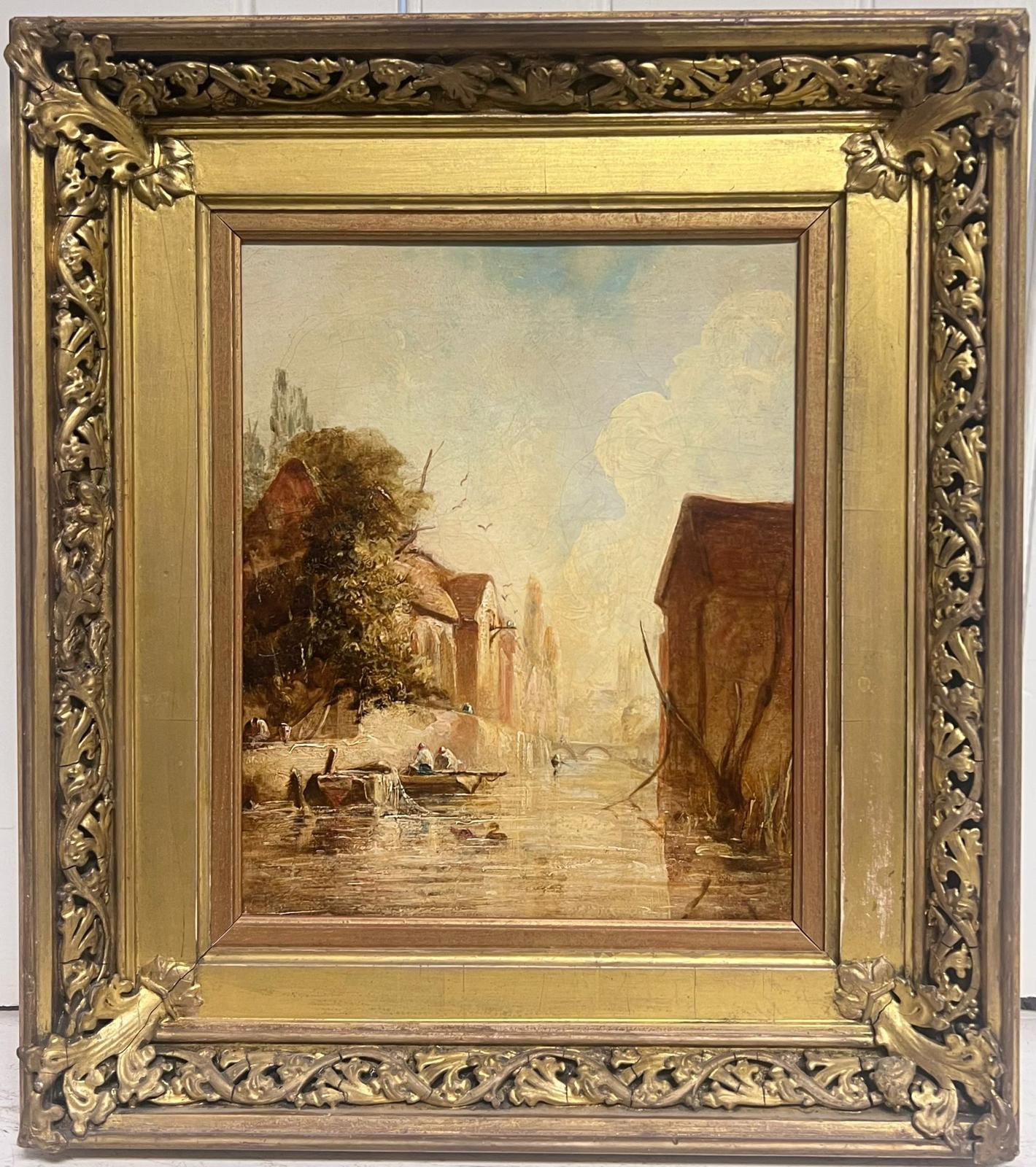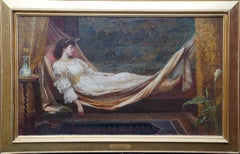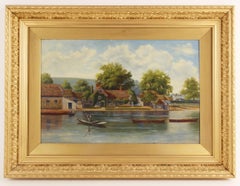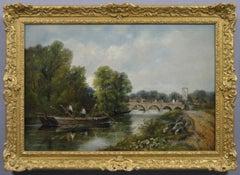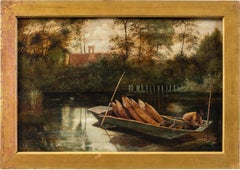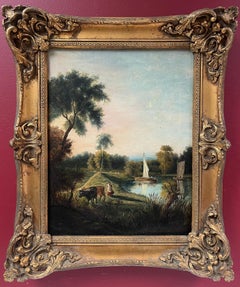Items Similar to The Convent Boat - British Victorian Pre-Raphaelite art religious oil painting
Want more images or videos?
Request additional images or videos from the seller
1 of 16
Arthur HughesThe Convent Boat - British Victorian Pre-Raphaelite art religious oil paintingCirca 1874
Circa 1874
$48,387.81
$60,484.7720% Off
£35,200
£44,00020% Off
€41,207.40
€51,509.2520% Off
CA$67,580.84
CA$84,476.0520% Off
A$73,293.02
A$91,616.2820% Off
CHF 38,496.28
CHF 48,120.3520% Off
MX$890,268.04
MX$1,112,835.0420% Off
NOK 481,720.04
NOK 602,150.0620% Off
SEK 453,566.32
SEK 566,957.9020% Off
DKK 307,772.87
DKK 384,716.0920% Off
About the Item
This stunning British Victorian Pre-Raphaelite oil painting is by noted artist Arthur Hughes. It was painted circa 1874 and has extensive provenance. The composition is of a novice nun leaving her family to cross a river, in the Convent Boat, to go to her new life in cloisters on the other side. The fact that the artist returned to the subject several times confirms his fondness for the composition. The painting shows the emotional moment in which a young novice leaves her family for the convent. The ramifications of her decision are laid bare for the viewer. Dressed as a bride of Christ, the novice's austere clothing contrasts with the sumptuous garb of those standing on the river bank. While her family lament her departure, she holds a prayer book and looks away solemnly, appearing resolute in her choice. Soft evening light descends over the trees and reflects serenely across the water. The convent walls, overgrown with dense ivy, suggest the institution's agedness, connecting it with England's spiritual heritage. This is a superb painting with wonderful detail and colouring, telling the story of a young woman's turning point in life. It is also an excellent example of Hughes immense skill as a Pre-Raphaelite Victorian artist.
Signed lower left.
Provenance: Bought by Mrs. Ann Fleming in 1963.
Sale Christie's, 25 March 1966, lot 145, as 'The last Farewell' bought by Naylor Leyland.
Sale, Sotheby's, 26 July 1967, lot 361 (£160) bought by David W. Hughes.
Sale, Sotheby's, 30 October 1968, lot 118 (£190) bought by Colson.
Sale, Sotheby's Belgravia, 22 February 1972, lot 109 (£650) The Fine Art Society.
Purchased from Fine Art Society in November 1973 by Michael Hasenclever.
Galerie R. Hartmann in November 1973.
Sale, Sotheby's Belgravia, 9 April 1980, lot 17 (£11,000) bought by David Crew-Read on behalf of Lloyd Webber.
Acquired from Lord Lloyd Webber by Mrs Jeremy Norris.
Private collection, UK Exhibited: London,The Aesthetic Movement and the Cult of Japan , The Fine Art Society, 3-27 October 1972 (no.24, repr. p.14)
Munich, Burne-Jones und der Einfluß der Prä-Raffaeliten, Michael Hasenclever, 29 November 1972 -10 January 1973 (No.11, DM16,500, repr.)
Baden-Baden, Germany, Staatliche Kunsthalle Baden-Baden 1973 (No.84, repr. colour, p.147)
Literature: M. Amory, ed. The Letters of Evelyn Waugh, 1980, p.607.
L. Roberts and S. Wildman, Arthur Hughes: His Life and Works, A Catalogue Raisonné, Woodbridge Suffolk:
Antique Collectors' Club, 1997, no.131.3. ill., p.184
Condition. Oil on canvas, image size is 28 inches by 17 inches and in excellent condition.
Frame. House in a fine gilt frame with oak slip and ornate corners. Framed size is 36 inches by 25 inches and in good condition.
Arthur Hughes (27 January 1832- 22 December 1915) was an English painter and illustrator associated with the Pre-Raphaelite Brotherhood. Hughes was born in London. In 1846 he entered the art school at Somerset House, his first master being Alfred Stevens, and later entered the Royal Academy schools. It was here, after reading a copy of The Germ, that he met John Everett Millais, Holman Hunt, and Dante Gabriel Rossetti, although he never became an official member of the Pre-Raphaelite group of painters. His first picture, Musidora, was hung at the Royal Academy when he was only 17, and thenceforth he contributed almost annually not only to the Royal Academy but later also to the Grosvenor and New Gallery exhibitions. After having his painting Ophelia hung near Millais' version of the same name, they became friends and Hughes served as the model for the male figure in The Proscribed Royalist. In 1855 Hughes married Tryphena Foord, his model for April Love. They had five children of whom one, Arthur Foord Hughes, also became a painter. Hughes died in Kew Green, London in 1915, leaving about 700 known paintings and drawings, along with over 750 book illustrations. Following the death of Tryphena Hughes in 1921, their daughter Emily had to move to a smaller house. There was, therefore, a shortage of space. As a result, she had her father's remaining preparatory sketches, and all his private papers and correspondence, destroyed. He was the uncle of Edward Robert Hughes. His best-known paintings are April Love and The Long Engagement, both of which depict troubled couples contemplating the transience of love and beauty. They were inspired by John Everett Millais's earlier "couple" paintings but place far greater emphasis on the pathos of human inability to maintain the freshness of youthful feeling in comparison to the regenerative power of nature. April Love was purchased from Hughes by William Morris. Like Millais, Hughes also painted Ophelia (which is housed at Toledo Museum of Art) and illustrated Keats's poem The Eve of St. Agnes. Hughes's version of the latter is in the form of a secular triptych, a technique he repeated for scenes from Shakespeare's As You Like It. His works are noted for their magical, glowing colouring and delicate draughtsmanship. The oil portrait Springtide, first exhibited in Dublin in 1855, features his wife Tryphena. In 1857 Hughes was persuaded by Dante Gabriel Rossetti to join with the group of young artists who were to head to Oxford to paint the walls of the newly-finished debating chamber of the Oxford Union Society. Rossetti had chosen the Legend of King Arthur as the theme of frescoes and Hughes was delegated to paint a panel depicting The Death of Arthur. Unfortunately the walls were not properly prepared for the paintings and they soon deteriorated and now only the barest outlines remain of the works.
- Creator:Arthur Hughes (1832 - 1915)
- Creation Year:Circa 1874
- Dimensions:Height: 25 in (63.5 cm)Width: 36 in (91.44 cm)Depth: 2 in (5.08 cm)
- Medium:
- Movement & Style:
- Period:
- Condition:
- Gallery Location:Hagley, GB
- Reference Number:1stDibs: LU853115671422
About the Seller
5.0
Platinum Seller
Premium sellers with a 4.7+ rating and 24-hour response times
1stDibs seller since 2018
463 sales on 1stDibs
Typical response time: <1 hour
- ShippingRetrieving quote...Shipping from: Hagley, United Kingdom
- Return Policy
Authenticity Guarantee
In the unlikely event there’s an issue with an item’s authenticity, contact us within 1 year for a full refund. DetailsMoney-Back Guarantee
If your item is not as described, is damaged in transit, or does not arrive, contact us within 7 days for a full refund. Details24-Hour Cancellation
You have a 24-hour grace period in which to reconsider your purchase, with no questions asked.Vetted Professional Sellers
Our world-class sellers must adhere to strict standards for service and quality, maintaining the integrity of our listings.Price-Match Guarantee
If you find that a seller listed the same item for a lower price elsewhere, we’ll match it.Trusted Global Delivery
Our best-in-class carrier network provides specialized shipping options worldwide, including custom delivery.More From This Seller
View AllThe Village Maids - British Victorian art exhibited RA 1880 watercolour painting
By Marcella M Walker
Located in Hagley, England
This stunning exhibited Pre-Raphaelite 19th century watercolour painting is by British Victorian female artist Marcella M Walker. The painting was painted in 1880 and exhibited at th...
Category
19th Century Pre-Raphaelite Figurative Drawings and Watercolors
Materials
Watercolor
Childhood of Dante - British Victorian Pre-Raphaelite figurative oil painting
Located in Hagley, England
This stunning British Victorian Pre-Raphaelite Royal Academy exhibited oil painting is by noted historical female artist and suffragette Jessie MacGregor. She was tutored by Lord Frederick Leighton at the Royal Academy art schools in the 1870's and his influence can be seen here. Painted in 1892 and exhibited that year, the subject matter is when Dante, (1265-1321) later an Italian Florentine poet, first met Beatrice, the love of his life when he was nine. They met in a gathering at her father's palazzo in Florence. She was a few months younger than Dante and dressed in a crimson dress. They never actually spoke for another nine years although Dante often observed her. They were both married off during this time, as was the custom then and Beatrice died aged only 24. Dante remained devoted to Beatrice for the rest of his life and she was his principal inspiration for much of his well known work, such as La Vita Nuova (The New Life) and La Divina Commedia (The Divine Comedy). (see below biography for more details on Dante and Beatrice).
This stunning Pre-Raphaelite oil painting depicts Beatrice kneeling on the grass, holding flowers and gazing up at Dante as he stands beside her, hands over her head, perhaps miming crowning her. Other children and their maids dance around them. Beyond them is a Florentine garden with beautiful arches and some figures to the right. To the left one can glimpse the landscape under a summer's sky. MacGregor has portrayed superb detail in the figures expressions and clothing with rich red and gold tones and the vivid blue sky echoing in the little boy's tunic. The brushwork is fantastic. MacGregor painted some fantastic paintings in her time, many of which were exhibited and now hang in art galleries. This painting is a superb example of her work, with excellent provenance and would grace any wall.
Signed twice 'Jessie Macgregor/1892' lower right.
Provenance. Anon. sale, Sotheby's, Belgravia, 11 December 1972, lot 195.
Exhibited London, Royal Academy, 1892, no. 905 entitled In the Childhood of Dante. From this time forward love ruled my heart.
Literature Royal Academy Illustrated, 1892, p. 78.
Condition. Oil on canvas, 65 inches by 35 inches and in good condition.
Frame. Housed in a gilt frame with ornate flower corners and reeded edge, 87 inches by 57 inches, in good condition.
Jessie MacGregor (1847–1919) was a British painter. She was born in Liverpool to a Scottish father, Alexander (1820-1898) and Liverpudlian mother, Sarah (1820-1894). She had an older brother and 7 younger siblings. MacGregor first learned drawing at the drawing academy in Liverpool run by her grandfather Andrew Hunt, a landscape painter. Her mother taught her to use water colours. Her parents went to live in London and she began to study painting there, becoming a pupil at the Royal Academy Schools in 1870 for seven years where her teachers were Lord Leighton, P. H. Calderon, R.A., and John Pettie, R.A. She won a gold medal at the Royal Academy for history painting in December 1871, the prescribed subject being An Act of Mercy. She was the second woman after Louisa Starr's gold medal in 1867, and the last woman to do so until 1909. She first exhibited at the RA whilst still a student, in 1871. She continued with a historical genre when history paintings were broadening their reach towards literature and romance. Her subjects were almost always women or children. MacGregor was made an Academician for the Liverpool Academy of Art in 1874. By 1880 she was using a studio on Elm Tree Road and exhibiting regularly at the Royal Academy. in 1884 her brother Archibald also started working from this address and they both had paintings at the RA that year. In 1888 she moved studio to Hill Road St John's Wood. In 1892 MacGregor had two painting at the RA, a portrait of Miss Phyllis Eden and our painting, In the Childhood of Dante. This was described as a fresh bit of Italian Childhood and harmonious colour grouping by the Western Daily Press. Portraits rarely got a mention in the papers but narrative works were much more popular. She lectured widely for the Victorian University extension scheme at the Arts Clubs of Liverpool, the National Gallery and Leighton House museum and other regional centres. MacGregor had a studio in Chalcot Gardens Hampstead from 1900 and began to get involved with women's issues. In 1904 she was on the committee of the Lyceum Club London along side Henrietta...
Category
1890s Pre-Raphaelite Figurative Paintings
Materials
Oil
$263,933 Sale Price
20% Off
Golden Daydream - British Victorian Pre-Raphaelite art portrait oil painting
Located in Hagley, England
This stunning British Victorian Pre-Raphaelite Royal Academy exhibited oil painting is by note female Suffragette artist Emily Mary Osborn. Painted in 1877 it was exhibited at the RA...
Category
1870s Pre-Raphaelite Portrait Paintings
Materials
Oil
$63,783 Sale Price
20% Off
Two Worlds - British Edwardian figurative interior oil painting religious art
Located in Hagley, England
This intriguing British Edwardian figurative interior oil painting is by noted artist Arthur Croft Mitchell. It is entitled Two Worlds verso and dated as c1910. The composition of th...
Category
1910s Realist Interior Paintings
Materials
Oil
A Stream in the Forest - British Victorian 1859 art landscape oil painting
By George Cole
Located in Hagley, England
A fine and very detailed large Victorian British landscape painting. Painted in oil on canvas it is by listed and exhibited Victorian artist George Cole, dated 1859. A wonderful larg...
Category
19th Century Realist Landscape Paintings
Materials
Oil
$6,378 Sale Price
20% Off
Dedham Watermill - British 19thC art landscape oil painting Constable country
By Frederick Waters Watts
Located in Hagley, England
This lovely oil painting, circa 1850, is by Frederick Waters Watts (1800-1862), a highly desired landscape painter from the 19th century. The painting titled "Dedham Watermill" is in...
Category
19th Century Impressionist Landscape Paintings
Materials
Oil
You May Also Like
Antique English Oil Painting River Scene Figure in Old Punt by British Town
Located in Cirencester, Gloucestershire
English school (late 19th/ early 20th century)
A river scene with figure in a punt,
oil painting on board: 11.5 x 17 inches
framed: 18 x 25 inches
condition: very good and presentabl...
Category
Late 19th Century Victorian Landscape Paintings
Materials
Oil
$1,754 Sale Price
69% Off
19th Century river landscape oil painting of figures on a boat near a bridge
By Frederick Waters Watts
Located in Nr Broadway, Worcestershire
Frederick Waters Watts
British, (1800-1870)
Aylesford Bridge, Kent
Oil on canvas, stencil mark to the stretcher
Image size: 19.5 inches x 29.25 inches
Size including frame: 25.5 inc...
Category
Early 19th Century Landscape Paintings
Materials
Canvas, Oil
Naturalistic British painter - 19th century landscape painting - River boat
Located in Varmo, IT
English painter (late 19th century) - River landscape with boat.
41 x 61 cm without frame, 49 x 70 cm with frame.
Antique oil painting on canvas, in a gilded wooden frame (not sig...
Category
Late 19th Century Naturalistic Landscape Paintings
Materials
Canvas, Oil
$598 Sale Price
28% Off
Fine Victorian English Rural Oil Painting Boat on River Farmer and Cattle
Located in Cirencester, Gloucestershire
Leading them Home
English School, mid 19th century
oil on board laid on canvas, framed
framed: 18.5 x 15.5 inches
painting : 14 x 11 inches
Provenance: private collection, the City o...
Category
Mid-19th Century Victorian Landscape Paintings
Materials
Oil
$1,319 Sale Price
20% Off
Large Framed Oil Painting River Landscape Ferry Boats Old Church Abbey Buildings
Located in Cirencester, Gloucestershire
Dutch School, late 20th century
oil on canvas, framed
framed: 32 x 43 inches
canvas: 26 x 36 inches
provenance: private collection, UK
The painting is in very good and presentable c...
Category
20th Century Victorian Landscape Paintings
Materials
Oil
Victorian Oil Painting Figures in Boat City River Scene Backwater
Located in Cirencester, Gloucestershire
Tending the Boat
English School, 19th century
circle of William Joseph Julius Caesar Bond (British 1833-1928)
oil on canvas, framed
f...
Category
19th Century Victorian Landscape Paintings
Materials
Oil
$1,099 Sale Price
20% Off
More Ways To Browse
Religious Art Art
Baden Baden
Antique Nun
Prayer Book
Antique Religious Oil Paintings
Antique Drawing Book
Dante Gabriel Rossetti
Girl Privates
Jack King
Jorunn Mulen
Margaret Thomas
Oil Painting And Sir
Old American Portraits
Peasant Girl Painting
Peter Max Zero
Pierre Mignard
Portrait Of A Knight
Portrait Painting Of Princess
